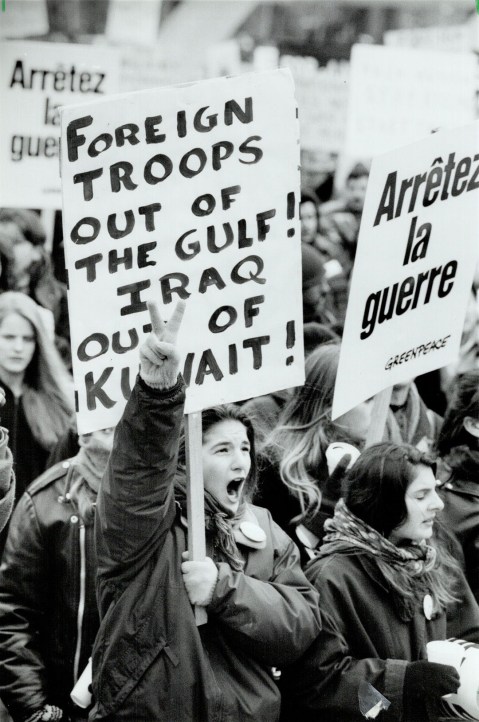In light of the death of the President George H. W. Bush on November 30, 2018, we share some of Howard Zinn’s writing about the Bush administration, excerpted from Chapter 21 of A People’s History of the United States. We also recommend the Democracy Now! segments, “Mehdi Hasan on George H.W. Bush’s Ignored Legacy: War Crimes, Racism and Obstruction of Justice” and “Remembering George H.W. Bush’s Inaction on AIDS at Home While Detaining HIV+ Haitians at Guantánamo.”
By Howard Zinn
Shortly after Bush took office, a government scientist prepared testimony for a Congressional committee on the dangerous effects of industrial uses of coal and other fossil fuels in contributing to “global warming,” a depletion of the earth’s protective ozone layer. The White House changed the testimony, over the scientist’s objections, to minimize the danger (Boston Globe, October 29, 1990). Again, business worries about regulation seemed to override the safety of the public.
The ecological crisis in the world had become so obviously serious that Pope John Paul II felt the need to rebuke the wealthy classes of the industrialized nations for creating that crisis: “Today, the dramatic threat of ecological breakdown is teaching us the extent to which greed and selfishness, both individual and collective, are contrary to the order of creation.”
At international conferences to deal with the perils of global warming, the European Community and Japan proposed specific levels and timetables for carbon dioxide emissions, in which the United States was the leading culprit. But, as the New York Times reported in the summer of 1991, “the Bush Administration fears that … it would hurt the nation’s economy in the short term for no demonstrable long-term climatic benefit.” Scientific opinion was quite clear on the long-term benefit, but this was not as important as “the economy”—that is, the needs of corporations.
Evidence became stronger by the late eighties that renewable energy sources (water, wind, sunlight) could produce more usable energy than nuclear plants, which were dangerous and expensive, and produced radioactive wastes that could not be safely disposed of. Yet the Reagan and Bush administrations made deep cuts (under Reagan, a 90 percent cut) in research into renewable energy possibilities.
. . .
As if to prove that the gigantic military establishment was still necessary, the Bush administration, in its four-year term, launched two wars: a “small” one against Panama and a massive one against Iraq.
Coming into office in 1989, George Bush was embarrassed by the new defiant posture of Panama’s dictator, General Manuel Noriega. Noriega’s regime was corrupt, brutal, authoritarian, but President Reagan and Vice-President Bush had overlooked this because Noriega was useful to the United States. He cooperated with the CIA in many ways, such as offering Panama as a base for contra operations against the Sandinista government of Nicaragua and meeting with Colonel Oliver North to discuss sabotage targets in Nicaragua. When he was director of the CIA in 1976-1977, Bush had protected Noriega.
But by 1987 Noriega’s usefulness was over, his activities in the drug trade were in the open, and he became a convenient target for an administration which wanted to prove that the United States, apparently unable to destroy the Castro regime or the Sandinistas or the revolutionary movement in El Salvador, was still a power in the Caribbean.
Claiming that it wanted to bring Noriega to trial as a drug trafficker (he had been indicted in Florida on that charge) and also that it needed to protect U.S. citizens (a military man and his wife had been threatened by Panamanian soldiers), the United States invaded Panama in December 1989, with 26,000 troops.
It was a quick victory. Noriega was captured and brought to Florida to stand trial (where he was subsequently found guilty and sent to prison). But in the invasion, neighborhoods in Panama City were bombarded and hundreds, perhaps thousands of civilians were killed. It was estimated that 14,000 were homeless. Writer Mark Hertsgaard noted that even if the official Pentagon figure of several hundred civilian casualties was correct, this meant that in Panama the U.S. had killed as many people as did the Chinese government in its notorious attack on student demonstrators at Tiananmen Square in Beijing six months earlier. A new president friendly to the United States was installed in Panama, but poverty and unemployment remained, and in 1992 the New York Times reported that the invasion and removal of Noriega “failed to staunch the flow of illicit narcotics through Panama.”
The United States, however, succeeded in one of its aims, to reestablish its strong influence over Panama. The Times reported: “The President [of Panama] and his key aides and the American Ambassador, Deane Hinton, have breakfast together once a week in a meeting that many Panamanians view as the place where important decisions are taken.”
Liberal Democrats (John Kerry and Ted Kennedy of Massachusetts, and many others) declared their support of the military action. The Democrats were being true to their historic role as supporters of military intervention, anxious to show that foreign policy was bipartisan. They seemed determined to show they were as tough (or as ruthless) as the Republicans.
But the Panama operation was on too small a scale to accomplish what both the Reagan and Bush administrations badly wanted: to overcome the American public’s abhorrence, since Vietnam, of foreign military interventions.
Two years later, the Gulf War against Iraq presented such an opportunity. Iraq, under the brutal dictatorship of Saddam Hussein, had taken over its small but oil-rich neighbor, Kuwait, in August 1990.

George Bush needed something at this point to boost his popularity among American voters. The Washington Post (October 16, 1990) had a front-page story headline: “Poll Shows Plunge in Public Confidence: Bush’s Rating Plummets.” The Post reported (October 28): “Some observers in his own party worry that the president will be forced to initiate combat to prevent further erosion of his support at home.”
On October 30, a secret decision was made for war against Iraq. The United Nations had responded to the invasion of Kuwait by establishing sanctions against Iraq. Witness after witness testified before Congressional committees in the fall of 1990 that the sanctions were having an effect and should continue. Secret CIA testimony to the Senate affirmed that Iraq’s imports and exports had been reduced by more than 90 percent because of the sanctions.
But after the November elections brought gains for the Democrats in Congress, Bush doubled American military forces in the Gulf, to 500,000, creating what was now clearly an offensive force rather than a defensive one. According to Elizabeth Drew, a writer for the New Yorker, Bush’s aide John Sununu “was telling people that a short successful war would be pure political gold for the President and would guarantee his re-election.”
Historian Jon Wiener, analyzing the domestic context of the war decision shortly afterward, wrote that “Bush abandoned sanctions and chose war because his time frame was a political one set by the approaching 1992 presidential elections.”
That and the long-time U.S. wish to have a decisive voice in the control of Middle East oil resources were the crucial elements in the decision to go to war against Iraq. Shortly after the war, as representatives of the thirteen oil-producing nations were about to gather in Geneva, the business correspondent of the New York Times wrote: “By virtue of its military victory the United States is likely to have more influence in the Organization of Petroleum Exporting Countries than any industrial nation has ever exercised.”
But those motives were not presented to the American public. It was told that the United States wanted to liberate Kuwait from Iraqi control. The major media dwelled on this as a reason for war, without noting that other countries had been invaded without the United States showing such concern (East Timor by Indonesia, Iran by Iraq, Lebanon by Israel, Mozambique by South Africa; to say nothing of countries invaded by the United States itself—Grenada, Panama).
The justification for war that seemed most compelling was that Iraq was on its way to building a nuclear bomb, but the evidence for this was very weak. Before the crisis over Kuwait, Western intelligence sources had estimated it would take Iraq three to ten years to build a nuclear weapon. Even if Iraq could build a bomb in a year or two, which was the most pessimistic estimate, it had no delivery system to send it anywhere. Besides, Israel already had nuclear weapons. And the United States had perhaps 30,000 of them. The Bush administration was trying hard to develop a paranoia in the nation about an Iraqi bomb which did not yet exist.
Bush seemed determined to go to war. There had been several chances to negotiate an Iraqi withdrawal from Kuwait right after the invasion, including an Iraqi proposal reported on August 29 by Newsday correspondent Knut Royce. But there was no response from the United States. When Secretary of State James Baker went to Geneva to meet with Iraqi foreign minister Tariq Aziz, the instruction from Bush was “no negotiations.”
Despite months of exhortation from Washington about the dangers of Saddam Hussein, surveys showed that less than half of the public favored military action.
In January 1991, Bush, apparently feeling the need for support, asked Congress to give him the authority to make war. This was not a declaration of war, as called for by the Constitution; but since Korea and Vietnam, that provision of the Constitution seemed dead, and even the “strict constructionists” on the Supreme Court who prided themselves on taking the words of the Constitution literally and seriously would not intervene.
Read more about the Bush administration in Chapter 21, “Carter-Reagan-Bush: The Bipartisan Consensus,” of A People’s History of the United States.



